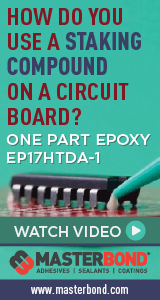|

|
|
Ask the Experts Member |
|||||
|
|||||
Kris RobersonManager of Assembly Technology IPC |
|||||
|
Kris Roberson has experience as a machine operator, machine and engineering technician and process engineer for companies including Motorola, and US Robotics. Kris is certified as an Master Instructor in IPC-7711 / 7721, IPC A-610 and IPC J-STD 001.
Kris Roberson has submitted responses to the following questions.
IPC-A-610 Class 3 - IPC-A-600 Class 2
If the end product is intended to be a class 3 product, then every step of the way (all standards ...
Dust contamination after selective soldering
There are a couple of things here. First, is what you are seeing truly "dross" or is it just flux ...
Removal of Coatings from PCBs
IPC-7711/7721B has a multitude of information including how to identify and remove coatings from a circuit board. To begin, the ...
Options for Reballing BGA Components
IPC-7711 "Rework, Modification, and Repair of Electronic Assemblies" has several procedures which all indicate that you should use flux and ...
ESD Grounding - 1 Meg Ohm Resistor
The short answer to your question is, "For operator safety". Think about it... what is the purpose of the grounding ...
Soldering Station Calibration
Itreally depends on the soldering station. Many stations today use a cartridge or powered tip design. There's nothing to calibrate ...
IPC 610 Class 3 with Missing Non-functional BGA Pads
There are a couple of things to consider. The first thing is, what do the customer drawings say? If the ...
Confused About IPC-A-610 Class 2 vs. Class 3
I can't explain where your company's thinking came from about the IPC-A-610 Classes. I can help explain more about the ...
Burned Chip Repair
The big decision on this is going to be which of the options (replace or repair) is more cost effective. ...
Bottom Side Chip Bonding
As a well known IPC member likes to say, "It depends." (D. Pauls - Rockwell Collins) Typically in a double ...
Twisting Multi-strand Wires
Most multi-stranded wires come twisted from the factory. If they are not twisted, it's possible that the wires were un-twisted ...
IPC-A-610 Solder Joint Acceptability Question
I think you've misinterpreted the section. First, don't forget that in section 1.2 there is a bold,italicized statement that says, ...
Through Hole Connector Solder Joint Hole Fill
When you say that one side is, "totally covered" I'm assuming that you mean that the solder destination side of ...
A Generic Reflow Profile
Using a generic profile in production will bring on more grief and scrap boards than you are willing to produce. ...
How to Remove Adhesive Bonded Resistors
I would suggestthe use of Thermal Soldering Tweezers. This tool features two heated points ina tweezer configuration. The heated tips ...
Fastening Surface Mounted Connectors Before or After Refow?
There are no IPC guidelines which will state that you should torque before or after soldering. Even torquing values are ...
Acceptable Conductor Repair
From the looks of the repair is seems as though the operator attempted to simply bridge solder across the damages ...
Gold Edge Contact Flux Contamination Failures
I'd say you need to run some tests. If the flux residue is causing interruptions or intermittent contact, then the ...
Gold Plated Hole Defects
There's a couple things here. First, exposed surface finish is not a defect condition according to IPC-A-610E. Section 5.2.1 states ...
Soldering Multilayer Ceramic Chip Capacitors
The answer isn't so much which end to solder first, the answer is going to be removing the thermal shock. ...
IPC-A-610 Criteria
The criteria for all of the IPC standards are gathered from all over the industry. The data comes from extensive ...
Acceptance Criteria for D-Pak Components
The D-PAK iscovered in the IPC-A-610E in section 8.3.14 on page 8-94, "Components withBottom Thermal Plane Terminations". It is also ...
Insufficient Plated Hole Fill with Electrolytic Capacitors
You stated 75%,but you didn't say whether that is hole fill or 75% coverage of the solder source side annular ...
IPA cleaning precautions
IPA is a very stale cleaning agent. For personnel, eye protection should be worn at all times. IPA can cause ...
Double Sided Reflow
Basically you are going to paste the boards, then apply a UV cured adhesive to the first side, place the ...
Stencil Aperture changes due to board finish?
Stencil apertures should not be affected by the change from ENIG to OSP. Aperture dimensions are related to the size ...
Oxidation on pads causes poor solder joints
Oxidation is the result of oxygen and moisture reacting with the alloys on the pads. In other terms, oxidation is ...
IR Reflow Issue
That sounds more like a component manufacturing issue rather than the reflow process. If your reflow is heating the component ...
Frequency range for ultrasonic cleaning
Ultrasonic cleaning is specifically addressed in the J-STD-001D document. You'll find that ultrasonic cleaning is not recommended for a populated ...
Removal and rework epoxy attached components
The answer to this question really depends on whether you are talking about a component simply "glued" to the PCB ...
Wave Soldering Problems
There are several things that could cause insufficient fill of the PTH. Insufficient/ incomplete flux coverage. Check your flux application ...
Through Hole Soldering on 24 Layer Board
For a thick board like yours, the only solution is auxiliary heating. There are a number of options for table ...
Wetting Problem SAC finished component
SAC alloy is typically compatible (wetting) with SnPb. I would suspect the problem is a poor plating or contamination issue ... |
|
Free Newsletter Subscription
Circuitnet is built for professionals who bear the responsibility of looking ahead, imagining the future, and preparing for it. Insert Your Email Address |
|

|



